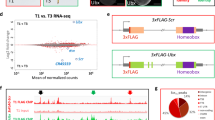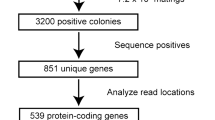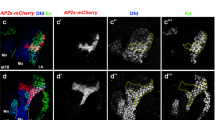Abstract
Nuclear hormone receptors and homeodomain proteins are two classes of transcription factor that regulate major developmental processes. Both depend on interactions with other proteins for specificity and activity. The Drosophila gene fushi tarazu (ftz)y which encodes a homeodomain protein1 (Ftz), is required zygo-tically for the formation of alternate segments in the developing embryo2. Here we show that the orphan nuclear receptor α Ftz-Fl (ref. 3), which is deposited in the egg during oogenesis4, is an obligatory cofactor for Ftz. The two proteins interact specifically and directly, both in vitro and in vivo, through a conserved domain in the Ftz polypeptide. This interaction suggests that other nuclear receptor/homeodomain protein interactions maybe important and common in developing organisms.
This is a preview of subscription content, access via your institution
Access options
Subscribe to this journal
Receive 51 print issues and online access
$199.00 per year
only $3.90 per issue
Buy this article
- Purchase on Springer Link
- Instant access to full article PDF
Prices may be subject to local taxes which are calculated during checkout
Similar content being viewed by others
References
Laughon, A. & Scott, M. P. Nature 310, 25–30 (1984).
Wakimoto, B. T. & Kaufman, T. C. Dev. Biol. 81, 51–64 (1981).
Lavorgna, G., Ueda, H., Clos, J. & Wu, C. Science 848–851 (1991).
Lavorgna, G., Karim, F., Thummel, C. & Wu, C. Proc. Natl Acad. Sci. USA 90, 3004–3008 (1993).
Ohno, C. K. & Petkovich, M. Mech. Dev. 40, 13–24 (1992).
Woodard, C., Baehrecke, E. & Thummel, C. Cell 79, 607–615 (1994).
Ueda, H., Sonoda, S., Brown, J. L., Scott, M. P. & Wu, C. Genes Dev. 4, 624–635 (1990).
Han, W., Yu, Y. & Pick, L. Mol. Cell. Biol. 13, 5549–5559 (1993).
Tsai, C. & Gergen, P. Development 121, 453–462 (1995).
Kornberg, T., Sidén, I., O'Farrell, P. & Simon, M. Cell 40, 45–53 (1985).
Baker, N. E. EMBO J. 6, 1765–1773 (1987).
DiNardo, S. & O'Farrell, P. H. Genes Dev. 1, 1212–1225 (1987).
Ingham, P. W., Baker, N. E. & Martinez-Arias, A. Nature 331, 73–75 (1988).
Fitzpatrick, V. D., Percival-Smith, A., Ingles, C. J. & Krause, H. M. Nature 356, 610–612 (1992).
Copeland, J., Nasiadka, A., Dietrich, B. & Krause, H. M. Nature 379, 162–165 (1996).
Jost, W., Yu, Y., Pick, L., Preiss, A. & Maier, D. Wilhelm Roux Arch. Dev. Biol. 205, 160–170 (1995).
Brown, S. J., Hilgenfeld, R. B. & Denell, R. E. Proc. Natl Acad. Sci. USA 91, 12922–12926 (1994).
Dawes, R., Dawson, I., Falciani, F., Tear, G. & Akam, M. Development 120, 1561–1572 (1994).
Stewart, J. J., Brown, S. J., Beeman, R. W. & Dennell, R. E. A. Nature 350, 72–74 (1991).
Ish-Horowicz, D., Pinchin, S. M., Ingham, P. W. & Gyurkovics, H. G. Cell 57, 223–232 (1989).
Struhl, G. Nature 318, 677–680 (1985).
Carroll, S. B. & Scott, M. P. Cell 45, 113–126 (1986).
Kassis, J. A. Genes Dev. 4, 433–443 (1990).
Mangelsdorf, D. J. & Evans, R. M. Cell 83, 841–850 (1996).
Erdélyi, M., Michon, A.-M., Guichet, A., Glotzer, J. B. & Ephrussi, A. Nature 377, 524–527 (1995).
Patel, N. H. et al. Cell 58, 955–966 (1989).
Krause, H. M., Klemenz, R. & Gehring, W. J. Genes Dev. 2, 1021–1036 (1988).
Ephrussi, A. & Lehmann, R. Nature 358, 387–392 (1992).
Tautz, D. & Pfeifle, C. Chromosoma 98, 81–85 (1989).
Staudt, L. M. et al. Science 241, 577–580 (1988).
Florence, B., Guichet, A., Ephrussi, A. & Laughon, A. Development 124, 839–847 (1997).
Yu, Y. et al. Nature (in the press).
Author information
Authors and Affiliations
Rights and permissions
About this article
Cite this article
Guichet, A., Copeland, J., Erdélyi, M. et al. The nuclear receptor homologue Ftz-F1 and the homeodomain protein Ftz are mutually dependent cofactors. Nature 385, 548–552 (1997). https://doi.org/10.1038/385548a0
Received:
Accepted:
Issue Date:
DOI: https://doi.org/10.1038/385548a0
This article is cited by
-
A single transcription factor facilitates an insect host combating Bacillus thuringiensis infection while maintaining fitness
Nature Communications (2022)
-
Non-specificity of transcription factor function in Drosophila melanogaster
Development Genes and Evolution (2017)
-
Hox genes, evo-devo, and the case of the ftz gene
Chromosoma (2016)
-
Functional conservation of Drosophila FTZ-F1 and its mammalian homologs suggests ligand-independent regulation of NR5A family transcriptional activity
Development Genes and Evolution (2013)
-
ftz-f1 and Hr39 opposing roles on EcR expression during Drosophila mushroom body neuron remodeling
Nature Neuroscience (2011)
Comments
By submitting a comment you agree to abide by our Terms and Community Guidelines. If you find something abusive or that does not comply with our terms or guidelines please flag it as inappropriate.



